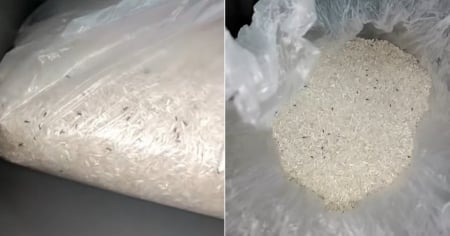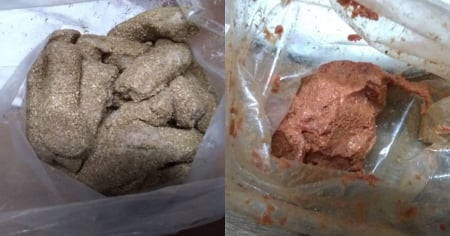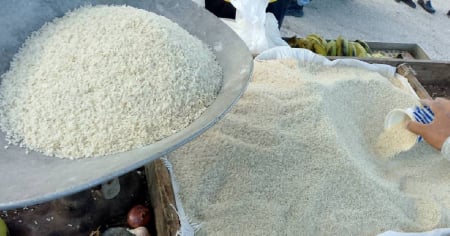
Related videos:
The production of rice in Cuba has drastically fallen in recent years,
Orlando Linares Morell, president of the Agricultural Group of the Ministry of Agriculture (Minag), attributes the decline to a lack of supplies and fuel, factors that have significantly reduced the cultivated area and the yields per hectare.
All of this has undoubtedly had a direct impact on the supply of the bodegas, the national market, and prices, which have exceeded the barrier of 300 pesos per pound with no signs of a decrease in the short term.
In the end, due to governmental inefficiency, families’ finances suffer the most, in addition to the stress of having to "hustle" for a product that is in high demand on Cuban tables.
A decline marked by a lack of supplies and fuel
Linares explained that the low results of national rice production are due to a lack of supplies and fuel, which has significantly limited the areas for cultivation and has reduced the productivity of the plantations.
In 2018, the country managed to sow 150,000 hectares and achieve 304,000 tons of rice, which covered nearly half of the national demand estimated at 700,000 tons per year.
However, starting in 2019, production began to decline, due to the internal economic crisis and the global impact of the COVID-19 pandemic. And, of course, due to the "tightening of the U.S. embargo," the official stated.
“El cultivo del arroz es muy técnico y requiere de un paquete tecnológico que el país hoy no dispone”, señaló Linares. Esto ha impactado en los rendimientos, which dropped from four tons per hectare in 2018 to only 1.7 tons in 2024.
Impact on the basic basket and the domestic market
In light of the drop in production, the Cuban government has chosen to import 100% of the rice intended for the basic food basket, which entails a significant expenditure of foreign currency in a challenging economic context. This trend will continue in 2025, as confirmed by the leader of Minag.
"The national production of rice only participated in markets, fairs, and some destinations of the Ministry of Domestic Trade. But the rice in the basic basket was completely imported," stated Linares.
The scarcity has led to a sustained increase in prices in non-state markets. This situation has caused concern among consumers, as rice is a staple food in the Cuban diet.
Plans for 2025: a slight upturn without definitive solutions
The Cuban government plans to increase the cultivated area in 2025, aiming to reach 100,000 hectares planted and a production of 100,000 tons of rice, which would represent a 20% growth compared to 2024.
Still, yields will remain low. "Last year we ended with a yield of 1.7 tons per hectare, and we have planned for 2.2 tons this year," Linares explained.
To boost the recovery of the rice sector, several cooperation projects with Vietnam and China are being explored, in addition to new foreign investments. There is also a focus on strengthening the productive chain with non-state management models to diversify production and ensure a greater supply.
The return of "popular rice" as an immediate alternative
One of the strategies being promoted by the regime is the so-called "popular rice", a practice that was successful during the hardest years of the Special Period, consisting of planting rice in small plots close to rivers, gullies, and lowlands.
In 2024, more than 20,000 producers participated in this modality, which helps reduce the use of inputs, fuel, and machinery. It is expected that in 2025, the number of farmers involved will increase and that the 70 municipalities with the highest production in the country will have specialized technicians to advise the producers.
In provinces like Pinar del Río, the rice grown under this model already accounts for nearly the same number of hectares as those managed by the Agroindustrial Grain Company, demonstrating its potential to alleviate the rice crisis in the country.
Without further delay
Rice production in Cuba is experiencing one of its worst crises in decades, with levels reaching only 30% of what was harvested in 2018 and a complete dependency on imports to meet basic needs.
Although authorities have outlined strategies to increase production by 2025, the outlook remains uncertain due to a lack of supplies, fuel, and technology. Meanwhile, Cubans are facing high prices and a limited supply, in an increasingly challenging economic context.
Frequently Asked Questions about the Rice Production Crisis in Cuba
Why has rice production in Cuba decreased so much?
The production of rice in Cuba has drastically declined due to a lack of supplies and fuel, which has significantly reduced the cultivated area and productivity. Furthermore, factors such as the internal economic crisis and the global impact of the COVID-19 pandemic have contributed to the decline in production since 2018.
What is the impact of rice shortages on the Cuban economy and population?
The shortage of rice in Cuba has led to a sustained increase in prices in non-state markets, where a pound of rice can exceed 300 pesos, making the product unaffordable for many. This situation has impacted families' access to a basic food in their diet, as well as increasing the government's spending in foreign currencies to import rice.
What measures is the Cuban government taking to improve rice production?
The Cuban government plans to increase the cultivated area in 2025 and is exploring cooperative projects with Vietnam and China, as well as encouraging production through non-state management methods. The "popular rice" model has also been implemented, aiming to reduce the use of inputs and machinery.
What role does rice importation play in today's Cuba?
Due to the decline in national production, Cuba has chosen to import 100% of the rice intended for the basic food basket, which implies a significant expenditure in foreign currency. This trend is expected to continue in 2025 according to authorities, as the country seeks to stabilize its internal production.
Filed under:






